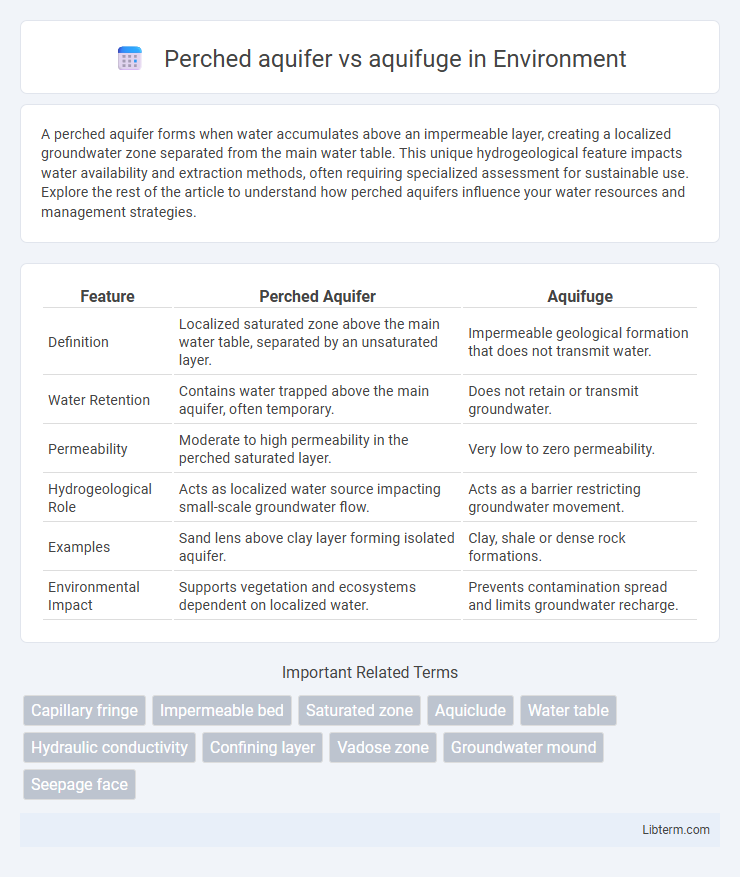A perched aquifer forms when water accumulates above an impermeable layer, creating a localized groundwater zone separated from the main water table. This unique hydrogeological feature impacts water availability and extraction methods, often requiring specialized assessment for sustainable use. Explore the rest of the article to understand how perched aquifers influence your water resources and management strategies.
Table of Comparison
| Feature | Perched Aquifer | Aquifuge |
|---|---|---|
| Definition | Localized saturated zone above the main water table, separated by an unsaturated layer. | Impermeable geological formation that does not transmit water. |
| Water Retention | Contains water trapped above the main aquifer, often temporary. | Does not retain or transmit groundwater. |
| Permeability | Moderate to high permeability in the perched saturated layer. | Very low to zero permeability. |
| Hydrogeological Role | Acts as localized water source impacting small-scale groundwater flow. | Acts as a barrier restricting groundwater movement. |
| Examples | Sand lens above clay layer forming isolated aquifer. | Clay, shale or dense rock formations. |
| Environmental Impact | Supports vegetation and ecosystems dependent on localized water. | Prevents contamination spread and limits groundwater recharge. |
Introduction to Perched Aquifer and Aquifuge
A perched aquifer is a localized groundwater zone situated above the main water table, separated by an impermeable layer called a capillary barrier that traps water in an isolated perched water table. An aquifuge, in contrast, is a geologic formation that is completely impermeable, preventing any water from passing through, thus acting as a barrier to groundwater flow. Understanding the distinctions between perched aquifers and aquifuges is crucial for groundwater management and hydrogeological studies.
Definition of Perched Aquifer
A perched aquifer is a localized groundwater zone situated above the main water table, separated by an impermeable layer such as clay or rock, which prevents it from merging with the regional aquifer below. This aquifer is typically smaller and perched at a higher elevation, often resulting from rainwater infiltrating through permeable soil but being trapped by the underlying impermeable stratum. In contrast, an aquifuge is a geologic formation completely impermeable to water, acting as a barrier that neither stores nor transmits groundwater.
Definition of Aquifuge
An aquifuge is a geological formation that is impermeable to water, preventing any groundwater flow through it, unlike an aquifer which stores and transmits water. A perched aquifer occurs above the main water table, separated by an aquifuge layer that restricts downward water movement. Understanding the distinction between aquifuge and perched aquifer is essential for hydrogeological studies and groundwater management.
Formation Processes of Perched Aquifers
Perched aquifers form when an impermeable layer, such as clay or rock, traps water above the main water table, creating localized saturated zones. This process occurs due to heterogeneous subsurface conditions where infiltration accumulates above a confining stratum, often in hillside or sloped terrains. In contrast, aquifuges are geological formations that lack permeability, preventing water flow and storage without forming distinct water-bearing zones.
Characteristics and Properties of Aquifuge
An aquifuge is an impermeable geological formation that completely obstructs groundwater flow, contrasting with a perched aquifer which is a localized saturated zone above the main water table, separated by an unsaturated layer. Key characteristics of an aquifuge include extremely low porosity and permeability, preventing any water storage or transmission, thus acting as a barrier within the subsurface hydrological system. Its properties make it crucial in defining groundwater boundaries and influencing the vertical movement of water in hydrogeological studies.
Key Differences between Perched Aquifer and Aquifuge
A perched aquifer is a localized zone of saturated rock or sediment above the main water table, separated by an impermeable layer, allowing for groundwater accumulation in otherwise unsaturated zones. An aquifuge, in contrast, is a geological formation that is completely impermeable to water, preventing any groundwater movement or storage. The key difference lies in permeability and water presence: perched aquifers store water above the regional water table due to an impermeable layer below, while aquifuges act as barriers that neither store nor transmit water.
Water Movement in Perched Aquifers vs Aquifuges
Water movement in perched aquifers occurs above the main water table where an impermeable layer traps water in localized zones, allowing limited lateral flow and temporary water storage. In contrast, aquifuges are completely impermeable layers that do not permit any water movement or storage, effectively blocking groundwater flow. The perched aquifer's isolated water pockets support temporary saturated conditions, whereas aquifuges act as barriers, preventing water infiltration and transmission.
Importance in Groundwater Management
Perched aquifers, characterized by localized zones of saturated soil above the main water table, are crucial for providing localized water sources in arid regions and influencing recharge dynamics. Aquifuges, impermeable layers that prevent water flow, act as natural barriers protecting groundwater quality by restricting contaminant migration and ensuring sustainable aquifer management. Understanding the interaction between perched aquifers and aquifuges enhances groundwater modeling accuracy and informs effective groundwater extraction policies.
Environmental Implications
Perched aquifers, localized above the main water table due to impermeable layers, can create isolated pockets of groundwater that support unique ecosystems but are vulnerable to contamination and depletion from surface activities. Aquifuges, impermeable rock formations that prevent water flow, act as natural barriers limiting groundwater movement, which helps contain pollutants but also restricts recharge and natural filtration processes. Understanding these hydrogeological distinctions is crucial for managing water resources and mitigating environmental impacts such as habitat disruption and groundwater contamination.
Conclusion: Choosing Between Perched Aquifer and Aquifuge
Choosing between a perched aquifer and an aquifuge depends on groundwater accessibility and permeability requirements. Perched aquifers provide localized water storage above impermeable layers, suitable for small-scale water supply or irrigation projects. Aquifuges act as impermeable barriers preventing water flow, essential for controlling groundwater movement and protecting aquifers from contamination.
Perched aquifer Infographic

 libterm.com
libterm.com